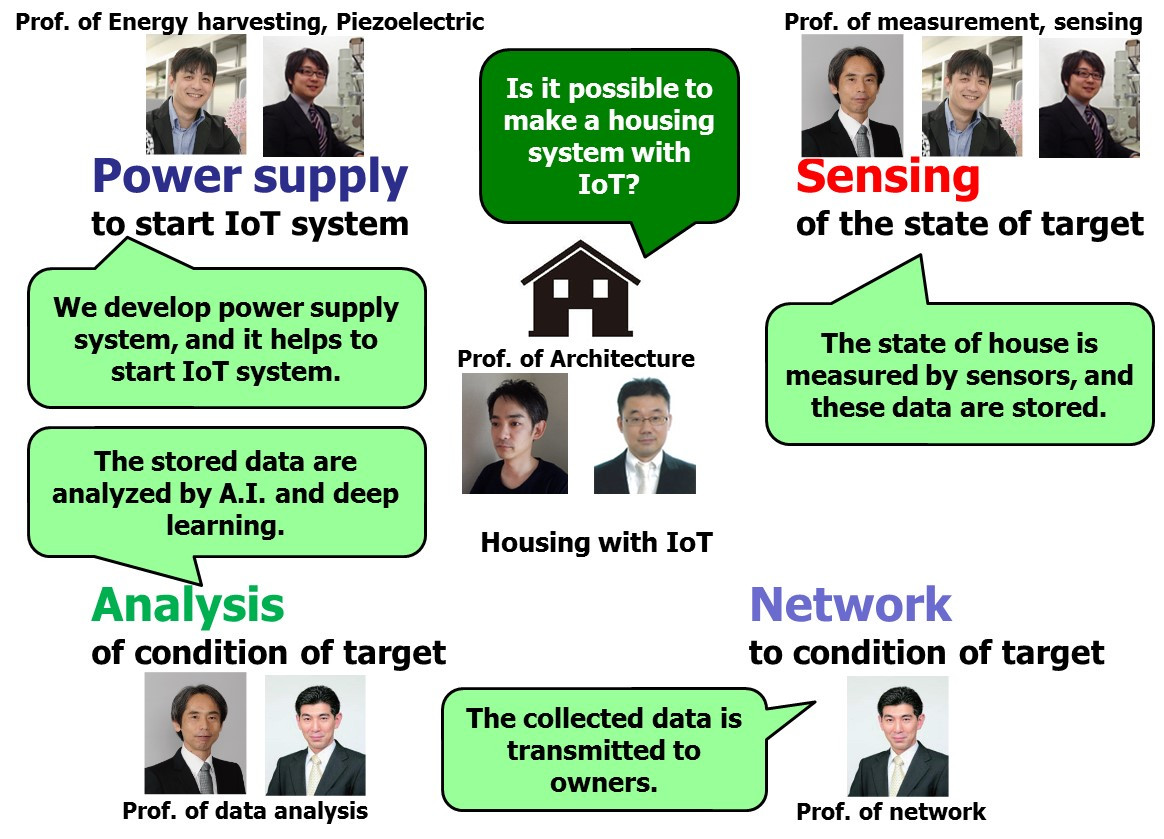Internet of Things for Buildings that Make Life Safe and Secure
Recently, there have been numerous discussions about the Internet of Things (IoT) delivering benefits in a variety of areas such as the provision of more comfortable human lifestyles and improvements in business efficiency. Most of the discussed topics and interests are focused on the development of specific underlying technologies.
These technology building blocks include:
1) Power supplies to start and operate IoT systems.
2) Sensors to measure and monitor the state of things and respond to any stimuli.
3) Networks, both narrow and wide area, to disseminate the status and responses of things.
4) Data analyses to identify the state of a system.
5) Data security for safety and security protection.
It is necessary to identify which are the most important areas of focus in any application of IoT. Recently, there have been many discussions in areas such as automobiles, housing, logistics and medicine, concerning applications to implement unmanned operation, automation, monitoring and support. These development trends of fundamental technologies related to IoT are widely recognized to have already started some decades ago.
Aim of our IoT system
We are focusing on the development of an IoT application in the architectural field, which supports everyday life, improves the quality of life, and promotes the safety and security of people. At present, we observe that the possibility of applying IoT in building architectures is mainly confined to the provision of comfortable indoor environments (temperature, humidity, lighting, energy savings, etc.), life support (housework, cooking, etc.), and home appliances with installed IoT systems. In fact, some home appliances with IoT capability have already been developed (air conditioner, freezer, oven, etc.). The main aim of these systems is to realize improvements in the quality of life.
We aim to develop an IoT application for building architectures that provides safety and security, particularly in the prevention of home crimes and in the event of natural disasters. Japan is one of the countries that experience frequent earthquakes, and various types of problem arise during these disasters. We are assuming the responsibility of solving these problems. We name our IoT-architecture approach an "Intellectual house".
Goals and application of our project
Japan is a country with frequent earthquake disasters and a large number of buildings have experienced severe damage from past earthquakes. After terrible seismic disasters, the following problems have been recognized:
- Large numbers of victims were injured, lost their houses, lost their families, etc.
- Insufficient food, water, and dairy supplies.
- Traffic problems such as traffic jams and transport disruption that cause delays in rescue and relief supplies.
- Shutting down of lifelines such as water, gas, power supply, etc.
- Occurrence of deserted homes and ghost towns because most victims cannot enter the damaged buildings for a while, which reduces home security.
- Decline in economic activities because supply chains were disrupted; workforces were short-staffed because workers participated in volunteer activities and caused poor traffic control.
Therefore, the following are required in disaster areas: 1) rapid rescue of victims, 2) rapid restoration of damaged buildings and infrastructures, and 3) rapid reconstruction of cities and countries.
To support these requirements, a rapid-response communication system is vital to identify whether a building is safe or damaged. Victims experience great uneasiness until the next action for restoration has been decided.
In past seismic disasters in Japan, a large amount of time was spent on investigations (few months) and a large number of investigators concentrated on the affected areas (few thousand people and volunteers). To prevent such wastage in time and human resources, our IoT system will estimate the state of buildings (whether safe or damaged) within a few minutes without the need for personal investigators, and the results will automatically and quickly be forwarded to the owners.
In the field of building structural engineering, experimental methods for measurement and visualization of the behavior and damage of a building have been established with high reliability. In addition, many evaluation methods for damage identification have been proposed. In general, the strain diagram of a column or a beam can be obtained from the measurements of a strain gauge of a building test specimen under loading conditions. The behavior of a building can then be visualized referring to these results and the location of the damage or the points of excitation can be identified. These methods can help the process of what, where, and how to measure the state of a building.
Key points for our IoT system
As previously mentioned, we focus on a warning system for safety and security during disasters. As a visualization of our IoT system, so to speak, the house itself notices pain or discomfort. In the development of this IoT system we consider the following areas: no external power supply; reliable methods for measuring the state of a building; big data analysis; and optimized alert networks.
1) Energy harvesting for power supply
In the event of a severe natural disaster, a large number of buildings and urban areas stop functioning, and power outages occur. To estimate the state of buildings in detail, a large number of measuring points is needed. Therefore, to supply power under these situations and demands, we propose to use energy harvesting, such as vibration under seismic or wind motions, and temperature difference in buildings. In other words, the house itself makes the power supply for the start-up IoT system.
2) Measuring the state of buildings
To identify the status of buildings, organic piezoelectric film is applied to measure the strain induced in the buildings. Piezoelectrics have been promising materials which offer electromechanical conversion for a sensor and an energy harvesting device, because of their easy installation into mechanical sources and relative simplicity compared with magnetic field-based generators. Furthermore, organic piezoelectric film is attractive because of its prospective features of strong robustness and high flexibility. However, there are a large number of measuring points in the buildings, and various conditions of the surface of building materials have to be taken into account. Therefore, the locations of measuring points will be systematically selected on the basis of the reference data obtained through building structural engineering tests.
3) Analysis method of big data of buildings
To diagnose the state of buildings, a large number of measured data points must be analyzed. A house contains various types of building materials (wood, concrete, steel, etc.) which complicates the data analysis. Therefore, we will deploy machine learning and artificial intelligence techniques.
4) Communication method and how to warn people from buildings
To identify the state of buildings after a disaster, the analyzed results will be sent to the relevant people. This information will help the victims to decide whether to go home or not, or whether or not the affected building needs repair. The volume of transmitted data is thereby increased, and the communication area can become wide. Therefore, determining the optimum communication method and devices is important to ensure rapid notification.
In order to collect data within buildings, low power consumption wireless modules should be selected because it is impractical to replace the batteries of wireless devices within buildings. To collect data from sensors in the wider area, longer distance wireless communications working on low frequency bands will be used for IoT. For the longer distance wireless communications, we choose Wi‑SUN, which works on the 920MHz band, with IEEE 802.15.4g for PHY and IEEE802.15.4e for MAC, which is ideal for intermittent low power consumption communications. Wi‑SUN access points placed every several hundred meters will forward the collected data from the sensors to the data center. After analyzing damage to the buildings from the collected sensor data, warnings will be sent to people by various wireless communication systems.
Interdisciplinary cooperation and industry-academia-municipality collaboration
We have just discussed the technology and objectives of fundamental and practical research. The development of an IoT system requires the integration of interdisciplinary methods, devices, and technologies. Therefore, we have launched an association of an interdisciplinary team, which is involved in a cross department project among electrical engineering, theoretical and applied physics, and architecture (Figure 1). Each researcher conducts individual research related to their specialized field, and cooperates with each other.
Figure 1: Relationships within our research team
Furthermore, we have initiated an industry-academia-municipality collaboration. Here, our academic team has requested the provincial city (in Oita prefecture, Japan) to prepare a test field for an actual building with an installed IoT system (Figure 2), which will be used as a testbed.
Figure 2: Conceptual image of the IoT system house
Figure 2 illustrates the notifications envisaged if a building encounters the domestic accident or home crime (Ordinary) as well as those that will occur in the event of a natural disaster (under Disaster conditions).
 Takumi Ito is an associate professor at Tokyo University of Science, Japan. He received the Dr. Eng. Degree in building structural engineering from the University of Tokyo in 2004. His Ph.D. thesis is "Evaluation method of ultimate seismic performance on steel building structures". From 2004 to 2009, he was in the University of Tokyo as research associate. Since 2009, he stayed in Tokyo University of Science. His research interests are building structures (steel, wooden structures), experimental methodology, and numerical simulation. He has published 42 papers, 57 proceedings, and other papers or reports. He received some paper awards of Architectural Institute of Japan or Japan Society of Steel Construction in 2003, 2004, and 2006. He can be contacted at t-ito@rs.kagu.tus.ac.jp
Takumi Ito is an associate professor at Tokyo University of Science, Japan. He received the Dr. Eng. Degree in building structural engineering from the University of Tokyo in 2004. His Ph.D. thesis is "Evaluation method of ultimate seismic performance on steel building structures". From 2004 to 2009, he was in the University of Tokyo as research associate. Since 2009, he stayed in Tokyo University of Science. His research interests are building structures (steel, wooden structures), experimental methodology, and numerical simulation. He has published 42 papers, 57 proceedings, and other papers or reports. He received some paper awards of Architectural Institute of Japan or Japan Society of Steel Construction in 2003, 2004, and 2006. He can be contacted at t-ito@rs.kagu.tus.ac.jp
 Mikio Hasegawa received his B.Eng., M.Eng., and Dr.Eng. degrees from Tokyo University of Science, Tokyo, Japan, in 1995, 1997, and 2000, respectively. From 1997 to 2000, he was a Research Fellow at the Japan Society for the Promotion of Science (JSPS). From 2000 to 2007, he was with the Communications Research Laboratory (CRL), Ministry of Posts and Telecommunications, which was reorganized as the National Institute of Information and Communications Technology (NICT) in 2004. Currently, he is a Professor in the Department of Electrical Engineering, Tokyo University of Science. He is a member of IEEE and has served as a Secretary of the Chapter Operation Committee for the IEEE Japan Council. His research interests include mobile networks, cognitive radio, chaos, neural networks and optimization techniques. He can be contacted at hasegawa@ee.kagu.tus.ac.jp
Mikio Hasegawa received his B.Eng., M.Eng., and Dr.Eng. degrees from Tokyo University of Science, Tokyo, Japan, in 1995, 1997, and 2000, respectively. From 1997 to 2000, he was a Research Fellow at the Japan Society for the Promotion of Science (JSPS). From 2000 to 2007, he was with the Communications Research Laboratory (CRL), Ministry of Posts and Telecommunications, which was reorganized as the National Institute of Information and Communications Technology (NICT) in 2004. Currently, he is a Professor in the Department of Electrical Engineering, Tokyo University of Science. He is a member of IEEE and has served as a Secretary of the Chapter Operation Committee for the IEEE Japan Council. His research interests include mobile networks, cognitive radio, chaos, neural networks and optimization techniques. He can be contacted at hasegawa@ee.kagu.tus.ac.jp
 Takashi Nakajima received his B.Sci., M. Sci., and Ph.D. degrees from Tokyo University of Science, Tokyo, Japan, in 2003, 2005, and 2008, respectively. In 2008-2012, he worked at Tokyo University of Science as a research associate. In 2012-2014, he was in the Institute of Materials Research, Tohoku University as a research associate. Currently, he is a junior associate professor in the Department of Applied Physics, Faculty of Science, Tokyo University of Science. He holds the concurrent post of PRESTO researcher of Japan Science and Technology Agency. His research has been focused on the functional properties of ferroelectric materials and ferroelectric devices including the piezoelectric energy harvester. He can be contacted at nakajima@rs.tus.ac.jp
Takashi Nakajima received his B.Sci., M. Sci., and Ph.D. degrees from Tokyo University of Science, Tokyo, Japan, in 2003, 2005, and 2008, respectively. In 2008-2012, he worked at Tokyo University of Science as a research associate. In 2012-2014, he was in the Institute of Materials Research, Tohoku University as a research associate. Currently, he is a junior associate professor in the Department of Applied Physics, Faculty of Science, Tokyo University of Science. He holds the concurrent post of PRESTO researcher of Japan Science and Technology Agency. His research has been focused on the functional properties of ferroelectric materials and ferroelectric devices including the piezoelectric energy harvester. He can be contacted at nakajima@rs.tus.ac.jp
Sign Up for IoT Technical Community Updates
Calendar of Events
IEEE 8th World Forum on Internet of Things (WF-IoT) 2022
26 October-11 November 2022
Call for Papers
IEEE Internet of Things Journal
Special issue on Towards Intelligence for Space-Air-Ground Integrated Internet of Things
Submission Deadline: 1 November 2022
Special issue on Smart Blockchain for IoT Trust, Security and Privacy
Submission Deadline: 15 November 2022
Past Issues
September 2022
July 2022
March 2022
January 2022
November 2021
September 2021
July 2021
May 2021
March 2021
January 2021
November 2020
July 2020
May 2020
March 2020
January 2020
November 2019
September 2019
July 2019
May 2019
March 2019
January 2019
November 2018
September 2018
July 2018
May 2018
March 2018
January 2018
November 2017
September 2017
July 2017
May 2017
March 2017
January 2017
November 2016
September 2016
July 2016
May 2016
March 2016
January 2016
November 2015
September 2015
July 2015
May 2015
March 2015
January 2015
November 2014
September 2014




